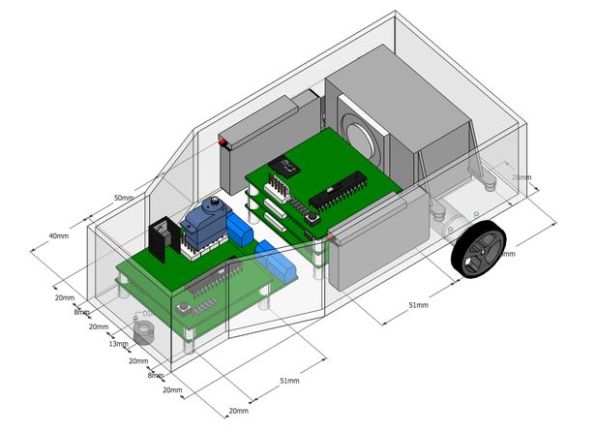JabberBot is controlled via an Android application over a bluetooth serial connection.
The guts of it are based on an I2C adaptation of the Adafruit WaveShield and MotorShield.
The bluetooth module is a Bluetooth Mate Silver from Sparkfun.
What does this thing do?
The android app running on the phone (powered by CyanogenMod) connects to the robot using the bluetooth serial port profile.
The software application has a dual joystick interface (like a gamepad) which controls the drive
wheels (left stick) and pan tilt mechanism (right stick).
You will need a multitouch capable phone for both sticks to work at the same time.
How does it do it?
On board the robot has 3 audio daughter boards with micro SD cards. These boards have their own ATMega
processor so the work of reading the audio files and decoding them is offloaded from the main processor.
These boards can play up to 16 bit stereo wav files however the sound is downsampled to 12bit mono.
The android application can send commands to any of these cards to play up to 3 sounds simultaneously with options for
how many loops to play. This is how the engine sound is created, it is a continuous loop of a short soundclip.
There is also a dedicated board for motor and servo control. This wasn’t necessary since there is very little
CPU workload in driving the motors and servos, but it frees up pins on the main board for expansion and an I2C controllable
motor driver board is cool anyway! 🙂

Each of the daughter boards needs 5 inputs signals from the motherboard, which are as follows:
Audio: VCC (5v), VCC/2 (3.3v), GND, SCL, SDA
Motor: VCC (5v), VCC2 (7.4v), GND, SCL, SDA Each of the audio boards sends the raw audio signal back to the motherboard so all the channels are mixed together before output.
I had to hack in an amplifier board at the last moment. I mistakenly didn’t build the amplifier into the main board, thinking it would be loud enough just using the voltage follower buffer from the adafruit waveshield. Also my amplifier board doesn’t perform as well as I would like. If anyone has suggestions for improvements I would love to hear them.
For more detail: JabberBot! The Arduino robot with an ATMega brain and bluetooth braun! 🙂

